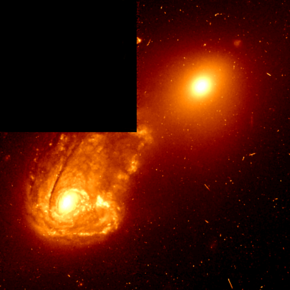| NGC 1142 | |
|---|---|
 NGC 1142 (left) by the Hubble Space Telescope | |
| Observation data (J2000 epoch) | |
| Constellation | Cetus |
| Right ascension | 02h 55m 12.1s[1] |
| Declination | −00° 11′ 01″[1] |
| Redshift | 0.028847 ± 0.000047 [1] |
| Heliocentric radial velocity | 8,648 ± 14 km/s[1] |
| Distance | 375 Mly (115 Mpc)[1] |
| Apparent magnitude (V) | 12.8 [2] |
| Characteristics | |
| Type | S pec (Ring B) [1] |
| Apparent size (V) | 1.1′ × 0.7′[1] |
| Notable features | Seyfert galaxy |
| Other designations | |
| NGC 1144, UGC 2389, Arp 118, VV 331a, Mrk 1504, CGCG 389-046, MCG +00-08-048, PGC 11012[1] | |
Preview warning: Page using Template:Infobox galaxy with unknown parameter "credit"
Preview warning: Page using Template:Infobox galaxy with unknown parameter "upright"

NGC 1142 (also known as NGC 1144) is a distorted spiral galaxy in the constellation of Cetus. It is located about 370 million light years away from Earth, which means, given its apparent dimensions, that NGC 1142 is approximately 170,000 light years across. It is a type 2 Seyfert galaxy. It interacts with the elliptical galaxy NGC 1141.
It was discovered by Albert Marth on October 5, 1864, who noted a location 40 arcminutes north of the real location, and it was discovered independently on November 17, 1876, by Édouard Stephan.[3]
- ^ a b c d e f g h "NASA/IPAC Extragalactic Database". Results for NGC 1142. Retrieved 2017-04-18.
- ^ "Revised NGC Data for NGC 11142". spider.seds.org. Retrieved 25 November 2018.
- ^ Seligman, Courtney. "NGC 1142 (= PGC 9817)". Celestial Atlas. Retrieved 19 November 2018.